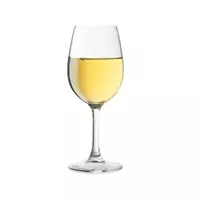Dry white wine

Dry white wine is classified as alcoholic beverages, the sugar content of which is no more than 0. 3 percent. The natural product is distinguished by a subtle harmonious soft taste, exquisite aroma and moderate acidity. It is unique in that in the process of manufacture the drink does not lose the specific features of the aroma of the grapes from which it is produced. In addition, it is revealed by a unique bouquet that contains the tones of wildflowers and herbs with subtle aromas of rose, acacia flower and strawberry shades. Shades of dry white wine can range from golden green to light straw depending on grape varieties, technology and region of manufacture.
This fragrant drink is appreciated by many grape wine lovers. In addition, dry white wine is often used in cooking, where it is customary to add it in the process of preparing various dishes and confectionery.
Types of dry white wine
In general, there are 2 types of white dry wine: directly white dry wine (with a percentage of alcohol of up to 13 units) and white dry special wine, which has a higher natural strength (alcohol - from 14 to 16 percent). The calorie content of white dry wine due to the low percentage of sugar is insignificant and is only 64 kcal.
Regardless of the types of dry white wine, the production process of this natural drink as a whole is not very different. Grapes for these purposes are collected exclusively mature, which is then crushed, with the removal of ridges, skin and bones, after which it is pressed and used to make wine.
In Russia, such brands of dry white wine as Chardonnay, Aligote, Riesling and Sauvignon Blanc are especially popular.
Benefits of dry white wine
The benefit of dry white wine lies primarily in the content of certain mineral acids, which contribute to improving the absorption of proteins. By the way, caffeic acid was found in this alcoholic drink, a distinctive feature of which is a special property - to liquefy and facilitate the release of sputum. That is why dry white wine is advised to be consumed by people with diseases of the bronchi and lungs.
In addition, the benefits of dry white wine are also evidenced by the fact that it is rich in magnesium and calcium, which are contained in an ionized form and therefore are well absorbed by the walls of the small intestine.
It is not for nothing that this wine is called "milk of the elderly, " because it is considered an excellent preventive agent of such diseases of elderly people as cataracts and Alzheimer's disease.
However, despite all the positive aspects, it should still be remembered that alcohol abuse is dangerous to human health. In any form, alcoholic beverages are contraindicated to the younger generation, pregnant and breastfeeding mothers, people with CNS, liver and kidney diseases.
dry white wine 64 kCal
Energy value of white dry wine (Ratio of proteins, fats, carbohydrates - ju):
Proteins: 0.2 g (~ 1 kCal)
Fats: 0 g (~ 0 kCal)
Carbohydrates: 0.3 g (~ 1 kCal)
Energy ratio (bj | y): 1% | 0% | 2%
 Español
Español Français
Français Português
Português Русский
Русский 简体中文
简体中文 繁體中文
繁體中文 日本語
日本語 한국어
한국어 العربية
العربية Türkçe
Türkçe Қазақ
Қазақ Deutsch
Deutsch Italiano
Italiano Українська
Українська
